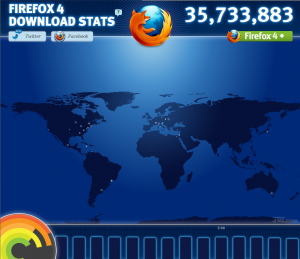[Update: before commenting, you should probably read this follow-up post that clarifies certain things about this post.]
On my recent vacation I was staying with a family member, let’s call her Karen (not her real name). She was a Google Chrome user, and I managed to convert her to a satisfied Firefox user. Here’s what I learnt along the way.
tl;dr:
Bad things about the experience:
- The third-party add-ons situation on Windows is awful.
- We need a “import history from Chrome” feature.
Good things about the experience:
- Mozilla’s non-profit nature is compelling, if you know about it.
- AdBlock Plus is great.
The Initial Situation
Karen is a moderately sophisticated computer user. She knows what a browser is, but didn’t know how many there were, who made them, or any notable differences between them.
Her machine that is probably 2 or 3 years old, and runs Windows Vista. She had used IE in the past (not sure which version) but didn’t like it, switched to Chrome at some point — she didn’t remember how or why — and found it to be much better. She was running Chrome 14.0.835.202 (no, that’s not an IP address!) which was the latest stable version.
She also had Firefox 3.6.17 installed, but judging from the profile she hadn’t used it much — there was very little history. She had the following Firefox add-ons installed:
- Java Console 6.0.20 and 6.0.27.
- The .NET Framework Assistant.
- Some media player thing.
- Some Norton “safe search” toolbar, and Symantec IPS, whatever that is.
(What is the Java Console? What is the .NET Framework Assistant? As far as I can tell they are (a) very common and (b) useless.)
I told her that I worked on Firefox and suggested that she try it and she was open to the idea. I talked about the differences between Firefox and Chrome and some of my work on Firefox. The thing that caught her attention most was that Mozilla is a non-profit organization. She hadn’t known this and it appealed to her greatly — she said that browser speed and the non-profit nature were the two most important things to her. She was also somewhat interested when I said that Firefox had an ad-blocking add-on. At the end of the conversation, she agreed to let me install Firefox and make it the default browser.
Installing Firefox
I removed the existing Firefox profile manually — I wasn’t sure if this was necessary, but I definitely wanted a fresh profile — and then uninstalled Firefox through the Control Panel. I then installed Firefox 7.0.1. (BTW, I stayed with Karen for two weeks at this point, and I had deliberately waited until Firefox 7 was out before doing this because I knew it had much lower memory usage than Firefox 6.)
An unexpected thing was that the Firefox installer asked me to close all the other running programs; it explained that this would mean that I wouldn’t have to reboot. I’m used to running Firefox on Mac and Linux so I’m not used to this, but I’m familiar enough with Windows that I wasn’t totally surprised. Still, it was annoying; Karen had MS Word and some other programs open and I had to go ask her if I needed to save anything before closing them. I realize this is Windows’ fault, not Firefox’s, but it was an obstacle.
Starting Firefox
When I started Firefox it asked me if I wanted to make it the default browser and I said yes. (I explained to Karen how to switch the default browser back to Chrome if she was unhappy with Firefox.)
It also asked me if I wanted to import history/bookmarks/etc from IE. But there was no equivalent for Chrome! Karen had a ton of bookmarks in Chrome, but fortunately she said she only used a handful of them so I was able to copy them manually into Firefox’s bookmarks toolbar (which I had to make visible). I’ve heard that someone is working on an “import from Chrome” feature to Firefox but I don’t know what the status is. We need it badly.
Once Firefox started, another unexpected thing was the state of the add-ons in the new profile. The Symantec add-ons (including the ugly Norton toolbar) were present and enabled. I had to disable them in about:addons; I wanted to completely uninstall them but I couldn’t, the “uninstall” button just wasn’t present. The Java Consoles and the media player were disabled because they were incompatible with 7.0.1, but I was also not able to uninstall them. This horrified me. Is it a Windows-only behaviour? Whatever the explanation, the default situation in a fresh install was that Firefox had several unnecessary, ugly additions, and it took some effort to remove them. I’m really hoping that the add-on confirmation screen that has been added to Firefox 8 will help improve this situation, because this was the single worst part of the process.
I then tweaked the location of the home and reload buttons so they were in exactly the same position as in Chrome. I probably didn’t need to do that, but with those changes made Firefox’s UI looked very similar to Chrome’s, and I wanted things to be as comfortable for her as possible.
The best part of the process was when I installed AdBlock Plus. With Karen watching, I visited nytimes.com in Chrome, and I had to skip past a video advertisement before even getting to the front page, and then the front page had heaps of ads. Then I visited in Firefox — no video, no ads. It was great!
Follow-up
A week or two later I sent Karen a follow-up email to check that everything was ok. She said “All is well! The ad blocking is a great feature.”
So, Firefox has a new and happy user, but there were some obstacles along the way, and the outcome probably wouldn’t have been so good if Karen hadn’t had a Firefox expert to help her.



